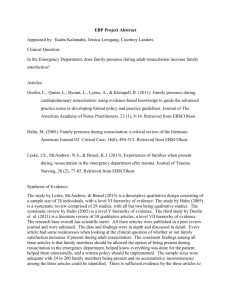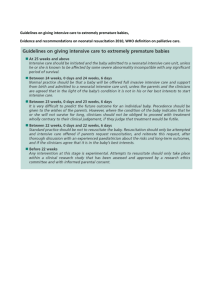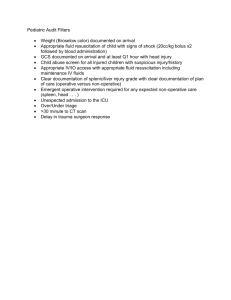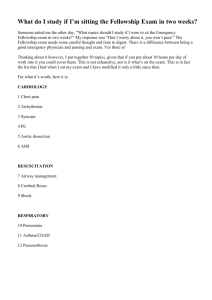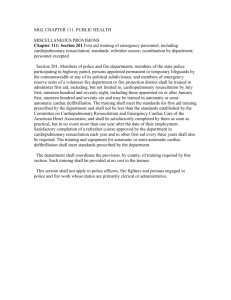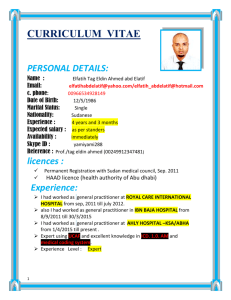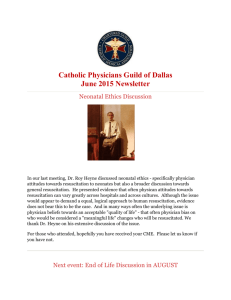Cardiopulmonary Resuscitation Policy
advertisement
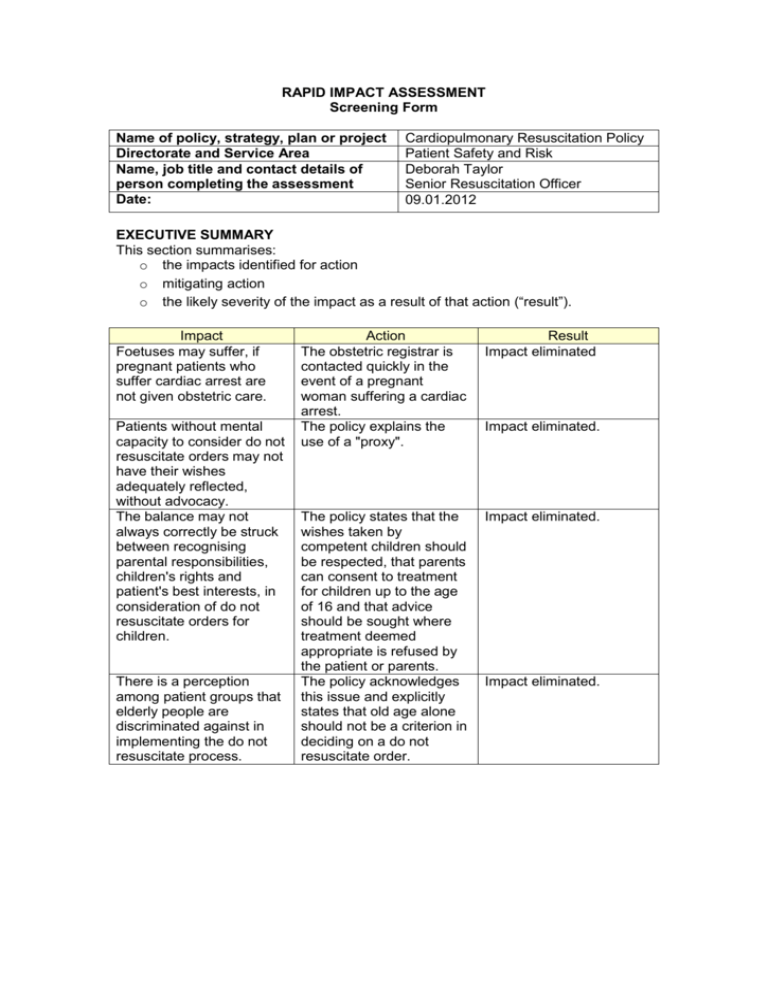
RAPID IMPACT ASSESSMENT Screening Form Name of policy, strategy, plan or project Directorate and Service Area Name, job title and contact details of person completing the assessment Date: Cardiopulmonary Resuscitation Policy Patient Safety and Risk Deborah Taylor Senior Resuscitation Officer 09.01.2012 EXECUTIVE SUMMARY This section summarises: o the impacts identified for action o mitigating action o the likely severity of the impact as a result of that action (“result”). Impact Foetuses may suffer, if pregnant patients who suffer cardiac arrest are not given obstetric care. Patients without mental capacity to consider do not resuscitate orders may not have their wishes adequately reflected, without advocacy. The balance may not always correctly be struck between recognising parental responsibilities, children's rights and patient's best interests, in consideration of do not resuscitate orders for children. There is a perception among patient groups that elderly people are discriminated against in implementing the do not resuscitate process. Action The obstetric registrar is contacted quickly in the event of a pregnant woman suffering a cardiac arrest. The policy explains the use of a "proxy". Result Impact eliminated The policy states that the wishes taken by competent children should be respected, that parents can consent to treatment for children up to the age of 16 and that advice should be sought where treatment deemed appropriate is refused by the patient or parents. The policy acknowledges this issue and explicitly states that old age alone should not be a criterion in deciding on a do not resuscitate order. Impact eliminated. Impact eliminated. Impact eliminated. 1. What is the main purpose of this policy / plan / service? The policy has been updated to include the members of the Medical emergency Team, Membership of the Resuscitation Group and Preparation for the new Treatment Escalation Plan. 2. Who does it affect? Carers √ Staff Delete as appropriate. 3. √ Patients √ Other (Visitors) √ What impact is it likely to have on different sections of the community / workforce, considering the “protected characteristics” below? Positive impact -- it could benefit Age √ Disability √ Sex including Transgender and Pregnancy / Maternity Negative impact -- it treats them less favourably or could do Negative impact -they could find it harder than others to benefit from it or they could be disadvantaged by it Non-impact – missed opportunities to promote equality Neutral -unlikely to have a specific effect √ Race √ Religion / belief √ Sexual orientation including Marriage / Civil Partnership In identifying the impact of your policy across these characteristics, please consider the following issues: - Fairness Does it treat everyone justly? - Respect Does it respect everyone as a person? - Equality Does it give everyone an equal chance to get whatever it is offering? - Dignity Does it treat everyone with dignity? - Autonomy Does it recognise everyone’s freedom to make decisions for themselves? √ 4. If you have identified any positive impacts (see above), what will you do to make the most of them? “Protected characteristic” affected: Issue Who did you ask to understand the issues or whose work did you look at? Resuscitation Council(UK)(2010) Resuscitation Group, Mental Capacity Act BMA/Law Society “Assessment of Mental Capacity” p.66 Action The issue is directly addressed in the policy. “Protected characteristic” affected: Issue Who did you ask to understand the issues or whose work did you look at? Disability Patients without mental capacity to consider do not resuscitate orders may not have their wishes adequately reflected, without advocacy. What did you find out What did you learn or about? confirm? Assessment Advocacy As stated in the policy Action as a result of above By whom? Policy writer. Age (Young people) The balance may not always correctly be struck between recognising parental responsibilities, children's rights and patient's best interests, in consideration of do not resuscitate orders for children. What did you find out What did you learn or about? confirm? Resuscitation Group, Mental Capacity Act Resuscitation Council(UK)(2010) Action The policy states that the wishes taken by competent children should be respected, that parents can consent to treatment for children up to the age of 16 and that advice should be sought where treatment deemed appropriate is refused by the patient or parents. When? During drafting. As stated in the policy Action as a result of above By whom? Policy writer. When? During drafting. “Protected characteristic” affected: Issue Who did you ask to understand the issues or whose work did you look at? Resuscitation Group, Related Trust Policies, As per references within policy Action The policy acknowledges this issue and explicitly states that old age alone should not be a criterion in deciding on a do not resuscitate order. “Protected characteristic” affected: Issue Who did you ask to understand the issues or whose work did you look at? Resuscitation Group, Related Trust Policies, As per references within policy Action The policy states that an obstetric registrar will be contacted quickly, when a pregnant woman has an arrest. Age (elderly people) There is a perception among patient groups that elderly people are discriminated against in implementing the do not resuscitate process. What did you find out What did you learn or about? confirm? Equality and Diversity As stated in policy Action as a result of above By whom? Policy writer. When? During drafting. Gender Foetuses may suffer, if pregnant patients who suffer cardiac arrest are not given obstetric care. What did you find out What did you learn or about? confirm? Resuscitation in Pregnancy Action as a result of above By whom? Policy writer. Foetuses may suffer, if pregnant patients who suffer cardiac arrest are not given obstetric care. When? During drafting. 5. If you have identified any missed opportunities (“non-impacts”), what will you do to take up any opportunities to promote equality? “Protected characteristic” affected: Issue Who did you ask to What did you find out What did you learn or understand the issues or about? confirm? whose work did you look at? Action Action as a result of above By whom? When? 6. If you have a identified a neutral impact, show who you have consulted or asked to confirm that this is the case, in the table below: Who did you ask or consult to confirm your neutral impacts? (Please list groups or individuals below. These may be internal or external and should include the groups approving the policy.) Tony Williams, Equality and Diversity Manager Resuscitation Group Clinical Effectiveness Committee Governance Committee If you need help with any aspect of this assessment, please contact: Tony Williams Equality and Diversity Manager Ext: 6942 tony.williams@rdeft.nhs.uk Please note: This impact assessment needs to be sent, with the policy, to the Equality & Diversity Manager at the following stages: - as part of consultation - prior to final ratification of the policy - when final ratification has been given.

